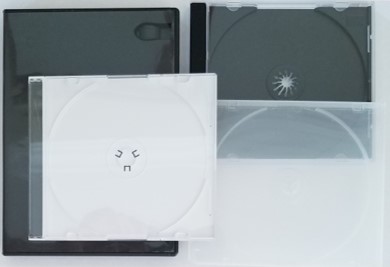- Home
- Storage of Discs
CD Storage and Optical Media Storage
CD storage, DVD storage, and other optical media storage as well as handling of the media are important variables in managing proper digital scrapbooking storage.
CD Storage Temperature and Humidity
First, to prevent premature failure of optical discs, it is important to store optical media under reasonable temperature and relative humidity environments. If the temperature is too hot and/or the humidity too high, this will accelerate the deterioration of optical discs and lead to shorter lifetimes. Storage in standard conditions will provide reasonable lifetimes for well-manufactured optical media, but poorly manufactured media may suffer. To extend the lifetimes considerably for good quality optical discs and even those which are of poor quality, cool temperatures and low humidity storage conditions are required. More information on the use of freezing cold storage can be found at this CD and DVD cold storage page.
Effect of Light on Optical Discs
Another storage issue for CD storage and other optical media storage is the amount of light exposure. Some digital optical discs such as CD-Rs, DVD-Rs, and some BD-Rs, use dyes to store the digital information. Not all dyes are of equal stability and some will fade with too much exposure to room light or sunlight. If the dyes fade, there will likely be loss of stored information. If stored properly in a jewel case and vertically on a shelf or in a storage cabinet, then light is not an issue. If discs remain on a desk, for example, and always exposed to light, then it could be a problem.
Storage Case for CDs, DVDs, and Blu-rays
The proper DVD CD storage container is a regular size jewel case. However, jewel cases come in many varieties such as the 2 cd jewel case or double CD jewel case. Storage of optical media in a proper enclosure will help prevent physical damage and chemical deterioration of the disc media. There are many other options for storing optical disc media such as slim jewel cases, sleeves made of paper, Tyvek, and various plastics, and several cd wallets or album type books and cases.

When mailing optical media, it is important to choose the right type of packaging to prevent damage. Storing cd album covers or jewel case insert materials in the case with the disc can be an issue as well, when long-term storage and stability is a concern.
Proper Recording and Disc Labeling
When information is written to CDs, DVDs, or Blu-rays, using an internal or external CD DVD burner, it is important to follow proper recording procedures using good CD DVD burning software in order to produce quality long lasting discs. For these recorded discs, it is often necessary to produce a label to identify the information stored on the disc. Placing this label on the CD storage enclosure is an option, but if the disc gets separated from the enclosure, the only way to identify the information on the disc is to read it, which can be an inconvenience. Therefore, labeling the actual disc does provide a definite benefit.
There are several ways to label optical discs. One of easiest and cheapest labeling methods is writing on the disc with a permanent archival marker. Adhesive labels are also available for placement on the top of discs. In addition, there are ink-jet and heat transfer printers for printing on optical disc media with special top surfaces that can accept the inks from these printers. Finally, there is a labeling method called LightScribe that uses Lightscribe discs, LightScribe software, and LightScribe enabled drives. Some of these methods are better than others when it comes to proper optical disc media storage. It is very important to use the proper labeling method for discs, otherwise irreversible damage and digital information loss will occur.
Disc Handling to Prevent Damage
To ensure discs are not damaged, proper handling of optical disc media is critical. Proper handling will minimize scratches and breakage of discs and prevent discs from contamination by fingerprints, dust, dirt, or debris. Some damage might be repairable and some contamination removable from the discs, but it is best to prevent these things from happening.